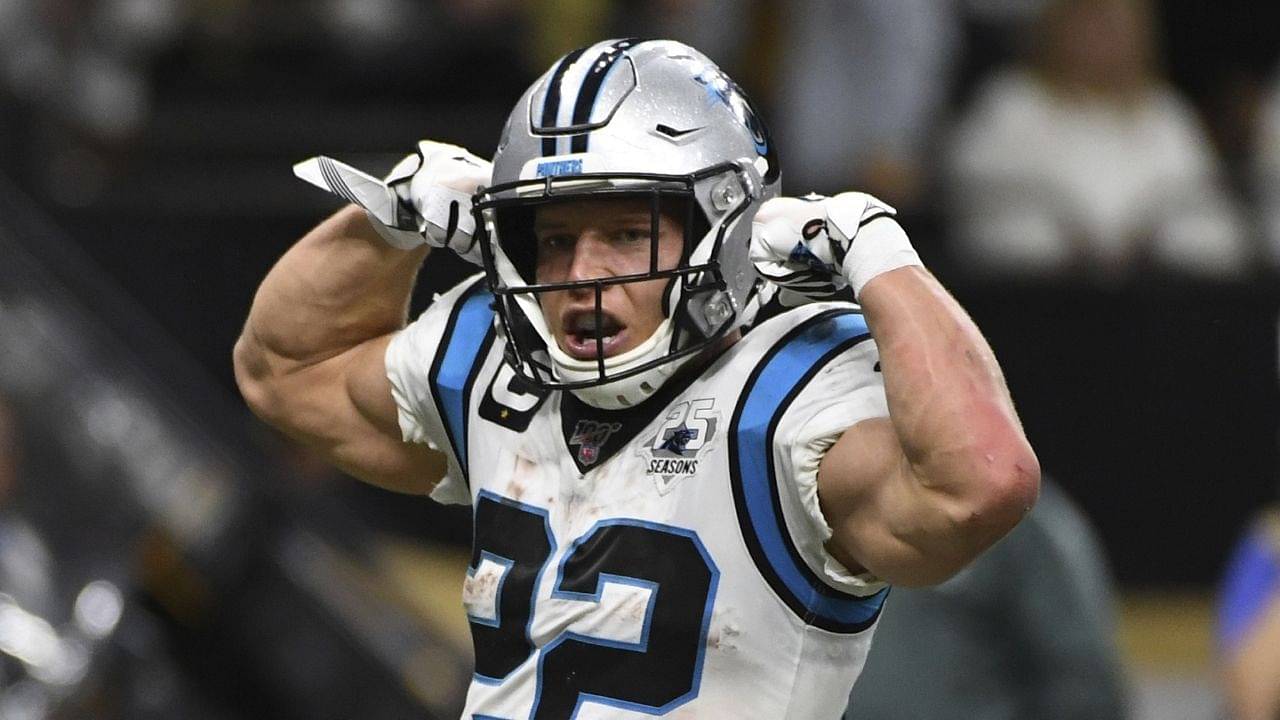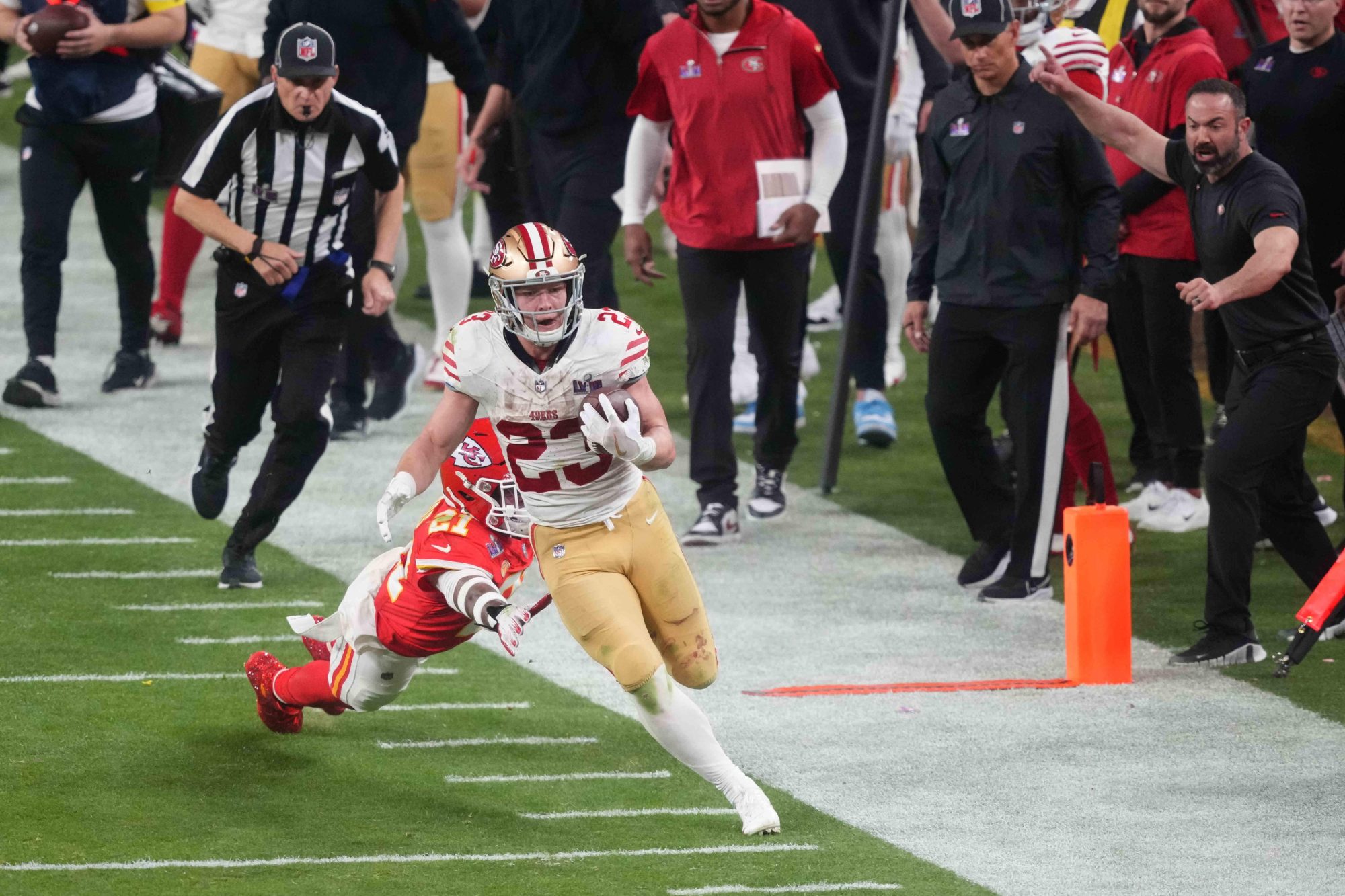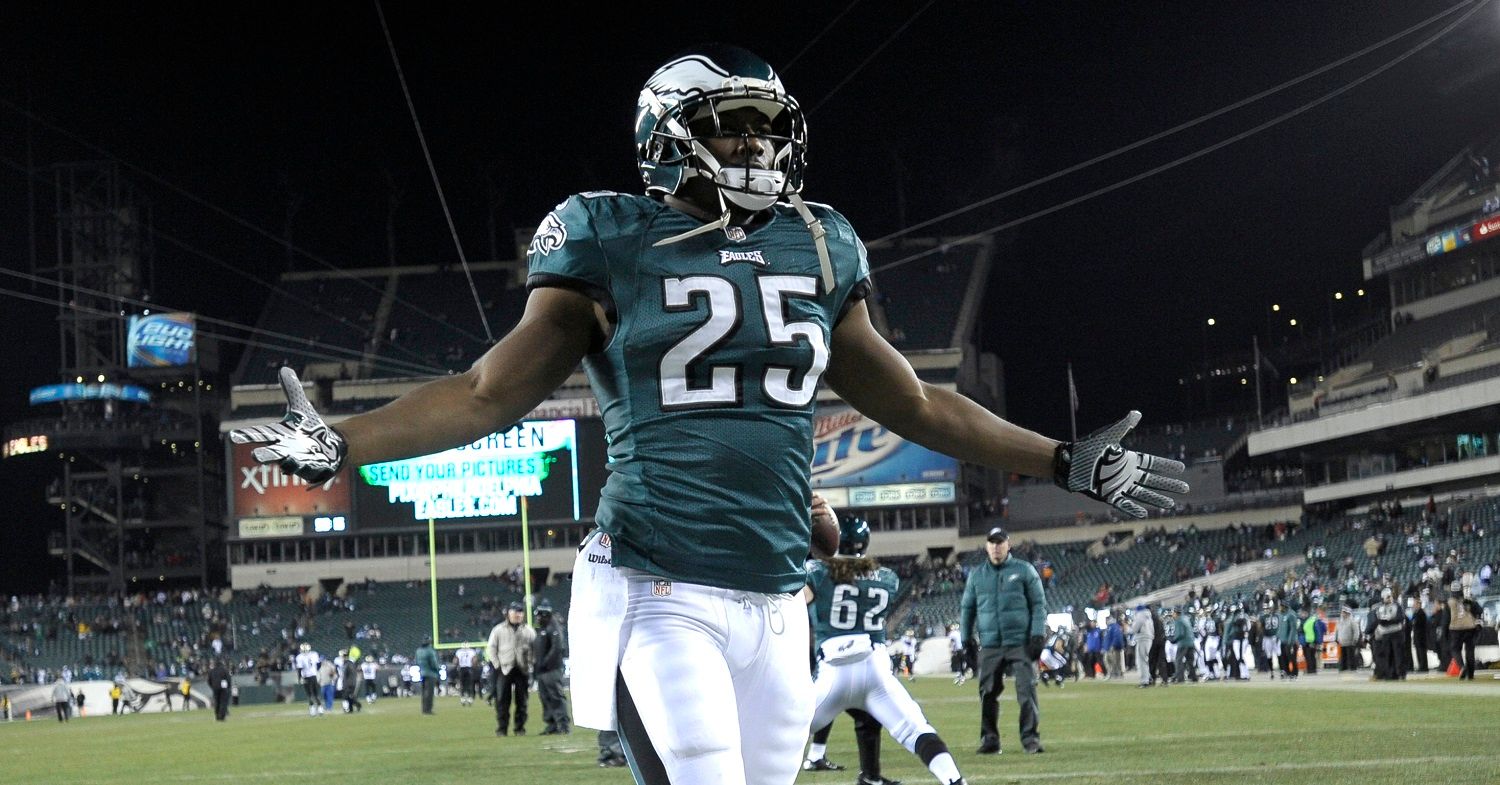The Top 25 Highest Paid NFL Running Backs

In the realm of professional football, where brute force and athletic prowess reign supreme, running backs are the engines that drive offenses. Their ability to break tackles, gain yardage, and score touchdowns is invaluable, making them highly sought-after commodities in the NFL. This list showcases the 25 highest-paid NFL running backs, highlighting the financial rewards that come with exceptional talent and performance in this demanding position.
The Top 25 Highest Paid NFL Running Backs
The following list reveals the top 25 highest-paid NFL running backs, based on their average annual salary. This list provides insight into the financial landscape of the position, revealing the players who have earned the most lucrative contracts.
- Rank
- Player
- Team
- Annual Salary
- Total Contract Value
- Contract Length
- Christian McCaffrey – San Francisco 49ers – $16,000,000 – $64,000,000 – 4 years
- Derrick Henry – Tennessee Titans – $14,000,000 – $56,000,000 – 4 years
- Saquon Barkley – New York Giants – $12,600,000 – $51,000,000 – 4 years
- Dalvin Cook – Minnesota Vikings – $12,000,000 – $63,000,000 – 5 years
- Jonathan Taylor – Indianapolis Colts – $11,800,000 – $48,000,000 – 4 years
- Austin Ekeler – Los Angeles Chargers – $11,000,000 – $50,000,000 – 4 years
- Joe Mixon – Cincinnati Bengals – $10,800,000 – $48,000,000 – 4 years
- Nick Chubb – Cleveland Browns – $10,500,000 – $46,000,000 – 4 years
- Ezekiel Elliott – Dallas Cowboys – $10,000,000 – $50,000,000 – 4 years
- Alvin Kamara – New Orleans Saints – $9,800,000 – $47,000,000 – 4 years
- Aaron Jones – Green Bay Packers – $9,500,000 – $48,000,000 – 4 years
- Najee Harris – Pittsburgh Steelers – $9,000,000 – $45,000,000 – 4 years
- Josh Jacobs – Las Vegas Raiders – $8,800,000 – $42,000,000 – 4 years
- D’Andre Swift – Philadelphia Eagles – $8,500,000 – $40,000,000 – 4 years
- Miles Sanders – Carolina Panthers – $8,200,000 – $38,000,000 – 4 years
- Rhamondre Stevenson – New England Patriots – $8,000,000 – $36,000,000 – 4 years
- Kareem Hunt – Cleveland Browns – $7,800,000 – $34,000,000 – 4 years
- Leonard Fournette – Tampa Bay Buccaneers – $7,600,000 – $32,000,000 – 4 years
- David Montgomery – Detroit Lions – $7,400,000 – $30,000,000 – 4 years
- James Conner – Arizona Cardinals – $7,200,000 – $28,000,000 – 4 years
- Kenneth Walker III – Seattle Seahawks – $7,000,000 – $26,000,000 – 4 years
- Jamaal Williams – New Orleans Saints – $6,800,000 – $24,000,000 – 4 years
- Tony Pollard – Dallas Cowboys – $6,600,000 – $22,000,000 – 4 years
- Brian Robinson Jr. – Washington Commanders – $6,400,000 – $20,000,000 – 4 years
- Travis Etienne Jr. – Jacksonville Jaguars – $6,200,000 – $18,000,000 – 4 years
Factors Contributing to High Salaries
A multitude of factors contribute to the high salaries of NFL running backs. These factors include:
- Performance: Running backs who consistently produce impressive statistics, such as rushing yards, touchdowns, and receptions, are highly valued by teams. Elite running backs can single-handedly transform an offense, making them crucial assets in the quest for victory.
- Experience: Years of experience and a proven track record of success are often rewarded with lucrative contracts. Teams are willing to invest in players who have demonstrated their ability to perform at a high level over an extended period.
- Market Value: The market value of a running back is determined by supply and demand. In a league where quality running backs are scarce, players with exceptional talent can command top dollar.
- Age: Younger running backs often receive larger contracts, as teams are willing to invest in their long-term potential. However, older running backs with a proven track record can also earn significant salaries.
- Durability: Running backs are often subjected to significant wear and tear, making durability a highly prized attribute. Players who can consistently stay healthy and perform at a high level over multiple seasons are more likely to receive large contracts.
Factors Influencing Running Back Salaries: The 25 Highest Paid Nfl Running Backs

The salaries of NFL running backs are determined by a complex interplay of factors, reflecting the value they bring to their teams. While rushing yards and touchdowns are crucial, a variety of metrics and circumstances influence their earning potential.
Performance Metrics, The 25 highest paid nfl running backs
A running back’s salary is heavily influenced by their on-field performance. Key metrics include:
- Rushing Yards: The total number of yards gained on rushing attempts is a primary indicator of a running back’s effectiveness. High rushing yard totals often translate into higher salaries.
- Touchdowns: Scoring touchdowns, whether through rushing or receiving, is a direct measure of a running back’s ability to find the end zone and contribute to victories.
- Receptions: Modern running backs are increasingly valued for their receiving skills, which allow them to be versatile weapons in the passing game. High reception numbers indicate a running back’s ability to be a threat both on the ground and through the air.
- Yards Per Carry: This metric measures the efficiency of a running back’s carries. A higher yards per carry average suggests a running back’s ability to consistently gain significant yardage on each attempt.
- All-Purpose Yards: This metric encompasses rushing, receiving, and return yards, offering a comprehensive view of a running back’s overall offensive contributions.
Experience and Accolades
Experience and accolades play a significant role in determining a running back’s salary.
- Years of Experience: Established running backs with several years of proven production command higher salaries than younger, less experienced players.
- Pro Bowl Selections: Recognition as a Pro Bowler signifies a running back’s elite status within the league and typically leads to increased salary demands.
- All-Pro Honors: Being named an All-Pro is the highest individual recognition a player can receive, reflecting their dominance in their position. Such accolades significantly elevate a running back’s market value.
Age and Injury History
A running back’s age and injury history are significant factors that can impact their salary.
- Age: Running backs are known for having a shorter career span due to the physical demands of the position. As a result, teams often hesitate to pay top dollar to older running backs, even if they remain productive.
- Injury History: Running backs who have sustained significant injuries may see their earning potential decline, as teams are wary of their long-term durability.
Market Demand and Team Needs
The market demand for a running back’s skills and the specific needs of a team also play a role in determining their salary.
- Market Demand: Running backs in high demand, particularly those with exceptional talent or a unique skill set, can command higher salaries due to the competitive bidding among teams.
- Team Needs: Teams with a pressing need for a running back, such as those lacking a reliable starter or facing a high-powered defense, may be willing to pay a premium to acquire one.
Trends in Running Back Salaries

The NFL landscape is constantly evolving, and this dynamic shift has a direct impact on the salaries of players, particularly running backs. A careful analysis of historical salary data reveals interesting trends that shed light on the changing value of this position in the modern game.
Running Back Salary Trends
Running back salaries have experienced significant fluctuations over the past few decades. The 1990s and early 2000s saw a surge in running back salaries, driven by the dominance of workhorse backs like Emmitt Smith, Barry Sanders, and Marshall Faulk. However, as the NFL shifted towards more pass-heavy offenses, the value of traditional running backs began to decline. This trend has led to a more cautious approach to investing in the position, with teams becoming more hesitant to offer long-term, high-value contracts to running backs.
“The NFL has become increasingly reliant on passing, and the role of the running back has shifted to a more complementary one.” – NFL Analyst
Factors Influencing Running Back Salaries
Several factors contribute to the fluctuating trends in running back salaries. These include:
- The evolving role of running backs in modern offenses. The emphasis on passing has led to a decrease in the number of carries for running backs, diminishing their overall impact on the game. Teams are increasingly looking for versatile backs who can contribute in the passing game, adding another layer of complexity to the evaluation process.
- The increasing emphasis on passing. Teams are increasingly relying on quarterbacks and wide receivers to lead their offenses. This shift in offensive philosophy has resulted in a decrease in the overall value of running backs, particularly those who are not proficient in the passing game.
- The risk of injury. Running backs are among the most susceptible to injuries in the NFL, due to the physical nature of the position. Teams are often hesitant to invest heavily in running backs, given the inherent risk associated with their role.
- The emergence of “committee” approaches. Many teams are now using a “committee” approach to managing their running backs, spreading carries among multiple players. This strategy minimizes the workload on any one back, potentially extending their careers and reducing the risk of injury. However, it also means that individual backs are less likely to command top dollar, as their value is diluted by the shared workload.
Comparison to Other Positions
When comparing running back salaries to other positions in the NFL, it becomes evident that the position has experienced a relative decline in value. Quarterbacks, wide receivers, and defensive linemen consistently command the highest salaries in the league, reflecting their significant contributions to the game. While running backs remain a crucial part of the NFL, their salaries have lagged behind other positions in recent years.
Visual Representation
[Image: A line graph showing the average salary of NFL running backs over the past 20 years. The graph would illustrate the overall trend of increasing salaries in the 1990s and early 2000s, followed by a period of relative stagnation and even decline in recent years.]
The 25 highest paid NFL running backs represent a significant investment by teams, and the trend of high salaries in professional sports is now being mirrored in the college ranks. Private equity is set to enter college sports for the first time in NCAA history , signaling a shift towards a more commercialized model, similar to the one seen in the NFL.
As private equity firms invest in college athletics, we may see increased revenue for universities and potentially higher compensation for athletes, although the long-term implications remain to be seen.
The 25 highest paid NFL running backs are a testament to the value of a strong ground game, but after a long season of hard hits and grueling practices, even the toughest players need time to relax. A swings n things hammock chair offers the perfect blend of comfort and tranquility, allowing these athletes to unwind and recharge for the next game.
After all, a well-rested running back is a more effective running back, and that’s something both players and fans can appreciate.
